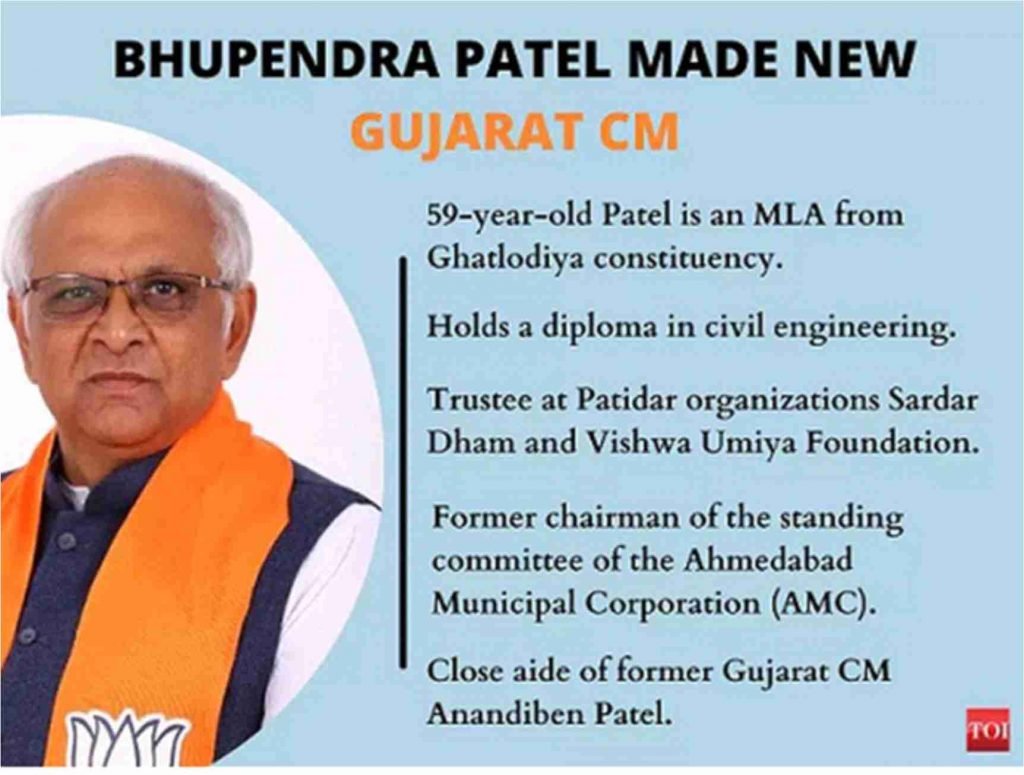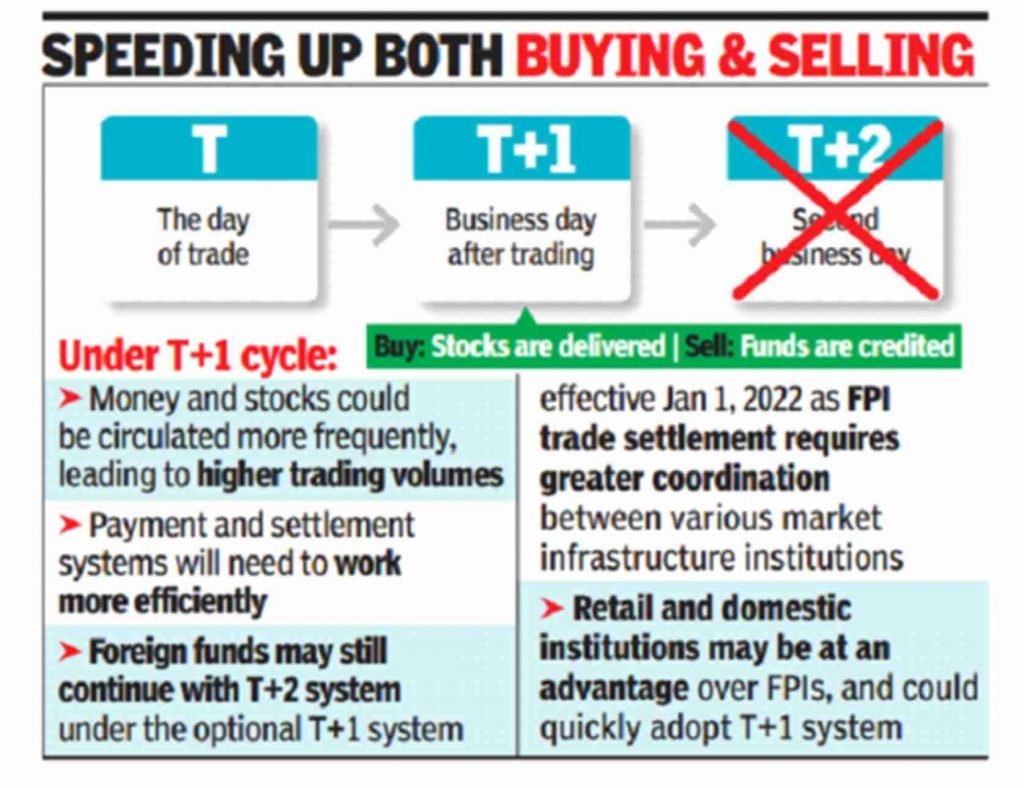Bhupendra Patel
All India Radio
GS 2: Parliament and State Legislature
Context:
- In a surprise choice, first-time legislator Bhupendra Patel was elected the new Chief Minister of Gujarat.
About:
- Bhupendra Patel will be the 17th Chief Minister of Gujarat. He will succeed the outgoing Chief Minister Vijay Rupani, who resigned from the post on Saturday.
- Patel became the MLA from the Ghatlodiya seat of Ahmedabad city in 2017. Mr. Bhupendra Patel is believed to be close to Anandiben Patel- Governor of Uttar Pradesh and former Chief Minister of Gujarat.

Chief Minister (CM):
- Each State has a Council of Ministers (CoM) to aid and advise the Governor in the exercise of his functions. CM is the head of the government in the State.
- CoM with the CM as its head exercises real authority at the State level.
- Under Article 164, the CM is appointed by the Governor.
- The person who commands the majority support in the State Legislative Assembly (Vidhan Sabha) is appointed as the CM by the Governor.
- The other Ministers are appointed by the Governor on the advice of the CM.
- The ministers included in the CoM must belong to either House of the State legislature.
- A person who is not a member of the State legislature may be appointed a minister, but he/she ceases to hold office if he/she is not elected to the State legislature within six months of his appointment.
Term:
- CM and other Ministers shall hold office during the pleasure of the Governor.
- CM cannot be dismissed by the governor as long as he enjoys the majority support in the legislative assembly.
- The State Legislative Assembly can also remove him by passing a vote of no-confidence against him.
Power and Functions:
- The constitutional position of the CM is more or less similar to that of the Prime Minister.
- The Governor allocates portfolios to the ministers on the advice of the
- CM presides over the Cabinet meetings. He/she coordinates the functioning of different ministries. He/she guides the functioning of the Cabinet.
- Bills are introduced by the ministers in the State legislature with his/her approval.
- He/she is the chief spokesman of the policies of his government both inside and outside the State Legislature.
- Under Article 167, CM is the sole link of communication between the Cabinet and the Governor.
- The Governor has the right to be informed by the CM about the decisions taken by the CoM.
- The Constitution provides that the CM shall communicate to the Governor all decisions of the CoM relating to the administration and the affairs of the State and proposals for legislation.
- CM furnishes such information relating to the administration of the affairs of the State and proposals for legislation as the Governor may call for.
- If the Governor so requires, the CM submits for consideration of the CoM any matter on which a decision has been taken by a minister but which has not been considered by the Cabinet.
- CMs of the States included in each zone act as Vice-Chairman of the Zonal Council for that zone by rotation, each holding office for a period of one year at a time.
T+1 Settlement System
The Indian Express
GS 3: Economy
Context:
- If stock Markus exchanges agree to the proposal for the T+1 settlement system made by the Securities and Exchange Board of India (SEBI), investors will get money for shares they sold or bought in their accounts faster, and in a safer and risk-free environment.
What has SEBI allowed?
- On September 7, SEBI allowed stock exchanges to start the T+1 system as an option in place of T+2.
- If it opts for the T+1 settlement cycle, the stock exchange will have to mandatorily continue with it for a minimum 6 months.
- Thereafter, if it intends to switch back to T+2, it will do so by giving one month’s advance notice to the market.
- Any subsequent switch (from T+1 to T+2 or vice versa) will be subject to a minimum period.
Why T+1 settlement?
- A shortened cycle not only reduces settlement time but also reduces and frees up the capital required to collateralise that risk.
- T+1 also reduces the number of outstanding unsettled trades at any instant, and thus decreases the unsettled exposure to Clearing Corporation by 50%.
- The narrower the settlement cycle, the narrower the time window for a counterparty insolvency/bankruptcy to impact the settlement of a trade.
- It also reduces the systemic risk.
Working
- If an investor sells shares on Tuesday, settlement of the trade takes place in two working days (T+2).
- The broker who handles the trade will get the money on Thursday, but will credit the amount in the investor’s account only by Friday.
- In effect, the investor will get the money only after three days.
- In T+1, settlement of the trade takes place in one working day and the investor will get the money on the following day.
- The move to T+1 will not require large operational or technical changes by market participants, nor will it cause fragmentation and risk to the core clearance and settlement ecosystem.
- In April 2002, stock exchanges had introduced a T+3 rolling settlement cycle. This was shortened to T+2 from April 1, 2003.

Why are foreign investors opposing it?
- Operational issues due to different geographies – time zones, information flow process, and foreign exchange problems.
- Difficulty to hedge the net India exposure in dollar terms at the end of the day under the T+1 system.
Global scenario:
- The US Depository Trust & Clearing Corporation (DTCC) highlighted the immediate benefits of T+1, including cost savings, reduced market risk, etc.
- DTCC estimates that a move to T+1 could bring a 41% reduction in the volatility component of National Securities Clearing Corporation’s margin.
- In order to move to T+1, industry participants must implement the necessary operational and business changes and regulators must be engaged.
National Financial Reporting Authority (NFRA)
The Hindu
GS 2: Statutory, regulatory, and various quasi-judicial bodies.
Context:
- NFRA will set up a single stakeholders’ advisory group and a research cell to support the group.
Need for setting NFRA:
- The decision to constitute NFRA was taken after the role of auditors and the Institute of Chartered Accountants of India came under the scanner for alleged lapses in various corporate scams including that at the Punjab National Bank.
- So, it acts as an audit regulator.
About NFRA:
- It was constituted on 1st October, 2018by the Government of India under section 132 (1) of the Companies Act, 2013.
- The Companies Act requires the NFRA to have a chairperson who will be appointed by the Central Government and a maximum of 15 members.
- Its duties are enshrined in Sub Section (2) of Section 132 of the Companies Act, 2013.

Powers:
It can undertake investigation related to the following class of companies and bodies corporate called Public Interest Entities:
- Companies whose securities are listed on any stock exchange in India or outside India.
- Unlisted public companies having paid-up capital of not less than Rs. 500 crores or having an annual turnover of not less than Rs. 1,000 crores or having, in the aggregate, outstanding loans, debentures and deposits of not less than Rs. 500 crores as on the 31st March of immediately preceding financial year.
- Insurance companies, banking companies, companies engaged in the generation or supply of electricity.
- Where professional or other misconduct is proved, it has the power to make an order for imposing a penalty.
Manipur: A Case for Asymmetric Federalism
The Hindu
GS 2: Polity and Governance
Context:
- The dissolution of Article 370 in 2019 and the integrationist approach followed by Manipur government were in lines with the majoritarian idea of homogenous nation opposing the asymmetric federalism.
Why is it said that India has asymmetric federalism?
- Asymmetric federalism or asymmetrical federalism is found in a federation in which different constituent states possess different powers.
- One or more of the sub-states has/have considerably more autonomy than the other sub-states, although they have the same constitutional status.
- There are some differences in the way some States and other constituent units of the Indian Union relate to the Centre.
- This creates a notable asymmetry in the way Indian federalism works.
- Articles 370, 371, 371A to Art 371H contains special provisions for certain states.
- The Sixth Schedule of the Constitution contains provisions for the administration of tribal areas in Assam, Meghalaya, Tripura, and Mizoram through autonomous councils.
What is the case of Manipur?
- Article 371C contains special provisions with respect to Manipur.
- The President may provide for the constitution of a committee of elected members from the Hill areas in the Assembly.
- It entrust “special responsibility” to the Governor to ensure its proper functioning.
- Recent attempts by Manipur government has been viewed as a move to delegitimise the demand for constitutional asymmetry.
- The Manipur (Hill Areas) Autonomous District Council (Amendment) Bill, 2021 seeks to increase the autonomy by increasing the membership of the six district councils to 31 members each and securing more powers to the councils.
- The government stalled the introduction and passage of the bill terming it to be sensitive.
- Induction of nine Assembly members from the valley areas into the Hill Areas Committee is seen as a direct assault on the constitutional protection conferred under Article 371C.
- Recent attempts of declaring areas around Chivu in the Indo-Myanmar border as a protected site and replacement of one of the three controversial monoliths, invoking the Forest Reserve Act are matters of concern.
- Also the hill areas attracted barely 1.91% out of Rs. 21,900 crore budgetary expenditure of Manipur from 2017-18 to 2020-21.

